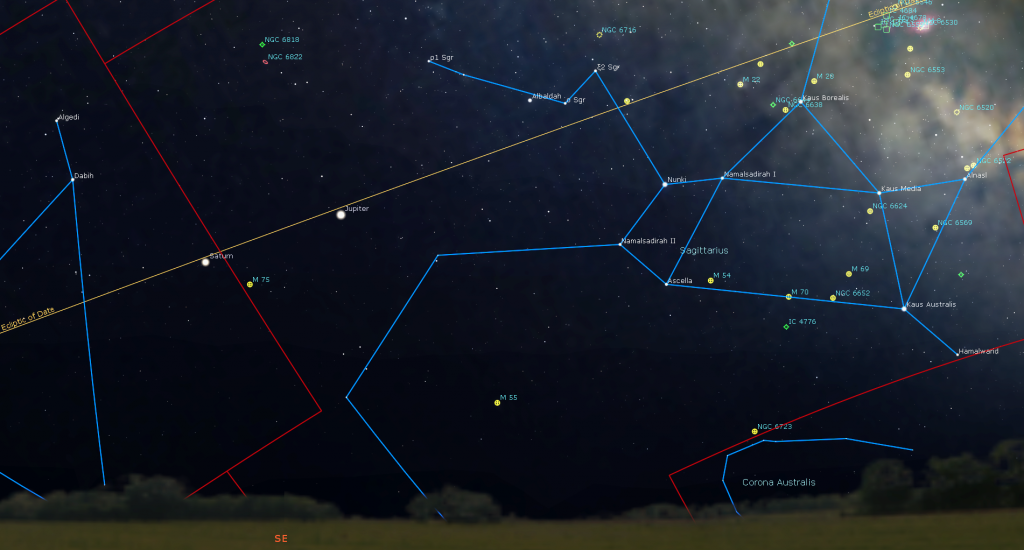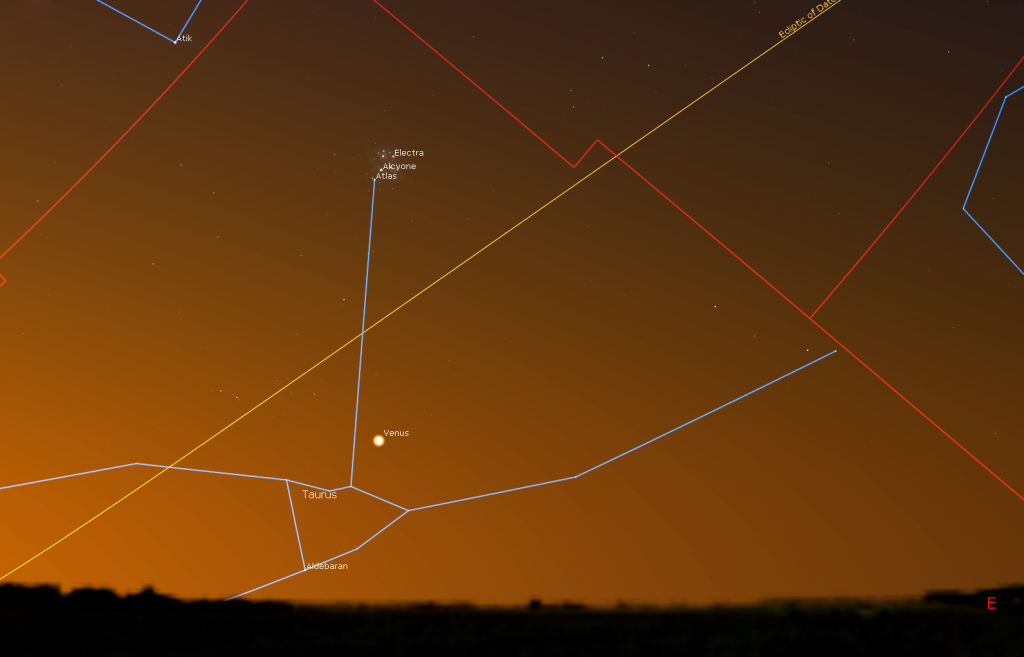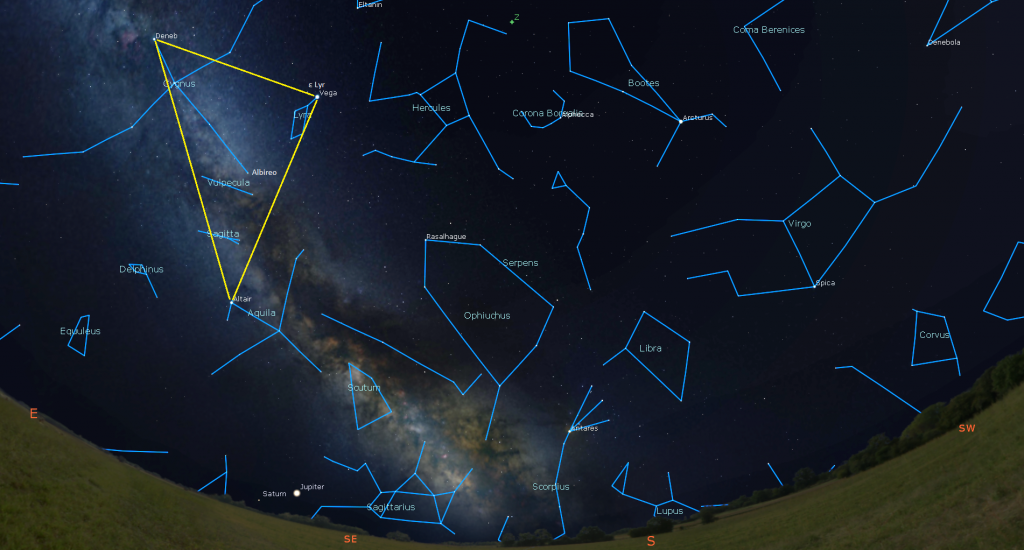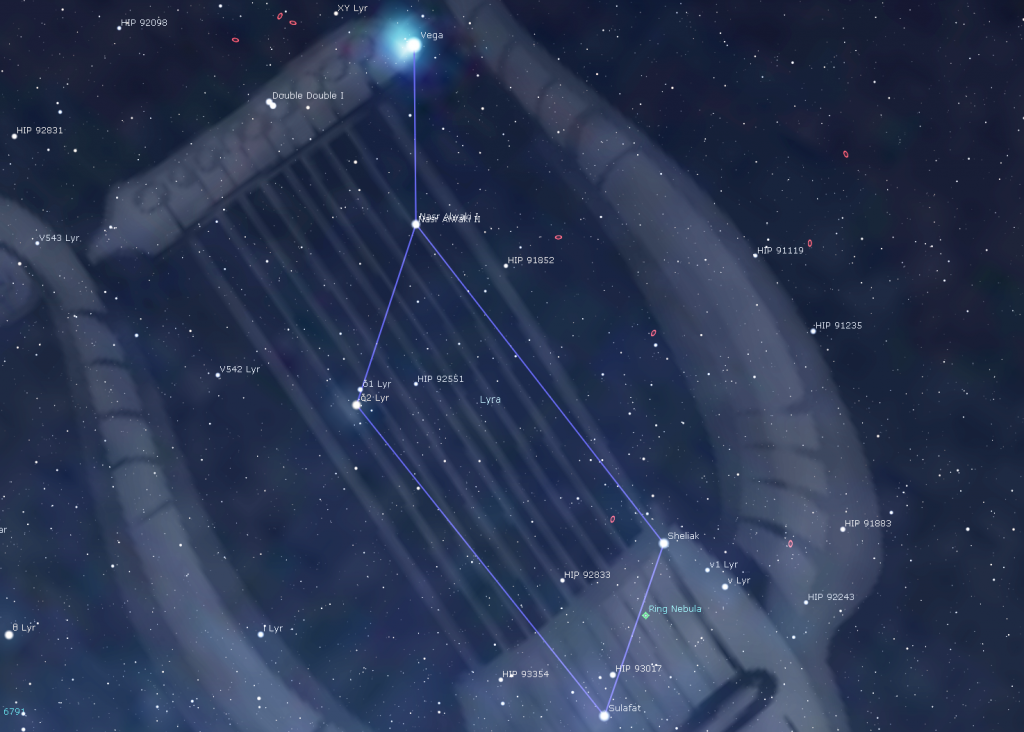The Crescent Moon Delights during Evening, Jupiter and Saturn Salsa at Midnight, and some Sights Described for Moonlit Nights!

The Moon as it will appear at 11 pm Eastern Daylight Time on Thursday, June 25, 2020. The prominent, dark, round crater Theophilus located mid-moon, near the terminator line, will change in appearance each night this week as its rim, and then its floor, fills with sunlight. These hourly images are available from NASA’s Moon Phase and Libration page at https://svs.gsfc.nasa.gov/4768
Hello, Summer Stargazers!
Here are your Astronomy Skylights for the week of June 21st, 2020 by Chris Vaughan. Feel free to pass this along to your friends and send me your comments, questions, and suggested topics. You can also follow me on Twitter as @astrogeoguy! Unless otherwise noted, all times are expressed in Eastern Time.
I can bring my Digital Starlab portable inflatable planetarium to your school or other daytime or evening event, or teach a session online. Contact me through AstroGeo.ca, and we’ll tour the Universe or the Earth’s interior together!
The crescent moon will return to view in the western evening sky all around the world this week, and sport the Lunar X on Saturday night. Jupiter and Venus will rise together in late evening and dance across the night sky together, followed hours later by brightening red Mars, and then even brighter Venus before sunrise. The moon’s presence in the evening sky will still let us see stars’ varied colours, the coffee and donut in Lyra, and some distinctive star patterns. Here are your Skylights!
The Moon and Planets
Following this morning’s new moon and annular solar eclipse, skywatchers the world over will see the moon return to the evening sky this week. It will wax fuller and climb higher every night as it travels the first quarter of its orbit around Earth.
Tonight (Sunday), sharp eyes might catch the very delicate young crescent moon positioned very low over the west-northwestern horizon just after sunset. If you DO see the moon tonight, look for Mercury sitting a palm’s width to the moon’s left. Monday night will offer you a much easier view of the moon. It will have climbed to sit a palm’s width to the lower left of the twin stars Pollux (on the left, or celestial east) and Castor (on the right, or celestial west) in Gemini. Those two stars are actually quite different in colour and brightness – perhaps they’re fraternal twins.
Every clear evening this week will offer you terrific views of the moon, especially through binoculars and telescopes of any size. (The moon is always completely safe to look at using optical aids when the sun is not nearby.) And because the moon will be above the horizon all day long, you can begin to explore it as soon as the sun gets low in the west.
The curved, pole-to-pole line that divides the lit and dark hemispheres of the moon is called the terminator. Anyone standing on the terminator will see the sun rising – on the moon, the Earth, or on any other world. The sunlight arriving there is nearly horizontal – so it casts long shadows from every crater rim, mountain peak, hill, and boulder. With no atmosphere on the moon to scatter light and soften shadows, the dramatically lit terrain looks spectacular, especially under magnification. As the moon waxes fuller night after night, the terminator is migrating across the moon from east to west – highlighting new regions. So pull the telescope out every clear night and see new things – or revisit the same locations to see how they change! For example, the deeper craters will begin the week with dark, shadowed floors and then they’ll fill with light as the sun climbs higher over them.
You might also notice Earthshine on the moon during the first few nights of this week. It’s sunlight reflected off Earth that slightly brightens the moon’s dark hemisphere.

On Tuesday night, the crescent moon will venture into Cancer (the Crab), and very close to the northern edge of an open star cluster called the Beehive and Messier 44. Observers in the Central and Mountain Time zones will be able to see the moon and the cluster while they are higher in the sky. The moon encounters this cluster frequently because the Beehive is located only 1 degree north of the ecliptic. The reduced brightness of the crescent moon should allow you to see the cluster’s stars and the moon in the field of view of your binoculars, especially if you are viewing them from a tropical latitude, where the sky will darken faster after sunset.
From Wednesday to Friday, the moon will traverse the large constellation of Leo (the Lion). By then, the moon will be setting closer to midnight. On the coming weekend, the moon will cross through Virgo (the Maiden). The bright, white star to the moon’s lower left (or celestial south) is Spica, also known as Alpha Virginis.
The moon will reach its first quarter phase on Sunday, June 28 at 4:16 am EDT, or 8:16 Greenwich Mean Time. At first quarter, the relative positions of the Earth, sun, and moon will cause everyone on Earth to see the moon half-illuminated – on its eastern (right-hand) side. Don’t put your telescope away! The moon will still be well-placed for viewing next week.
I’m getting excited! By staying up extra-late recently, I’ve already seen Jupiter, Saturn, and Mars. But those planets will soon rise early enough for non-Night-Owls to see them gleaming in the evening sky.
This week, very bright, white Jupiter will rise over the east-southeastern horizon at about 10:30 pm in your local time zone. Dimmer, yellow-tinted Saturn will rise about 15 minutes later. For the rest of this year, those two gas giant planets will dance across the sky together, with Saturn on the left (east). Look for the stars of Sagittarius (the Archer) and the Milky Way to their right (west). For now, Jupiter might catch your eye through a southerly window during the wee hours of the night because the planets won’t be climbing any higher than about 23 degrees above the horizon. Before dawn you’ll find them sitting not very high above the southwestern horizon. Saturn will disappear into the brightening sky before Jupiter.

For several weeks, Jupiter and Saturn have been positioned above, and to either side of, a globular star cluster named Messier 75 (or NGC 6864). The magnitude 9.2 cluster should be visible in binoculars and backyard telescopes as a small, fuzzy patch. This week, the cluster will be located approximately two finger widths to the lower right (or 2 degrees to the celestial south) of Saturn. Every morning, the planets’ orbital motions will carry them a little bit to the right (west) compared to the cluster. Next week, they’ll begin to leave it behind them.
Even binoculars will reveal Jupiter’s four large Galilean moons named Io, Europa, Ganymede, and Callisto as they dance around the planet from night to night. And a modest-sized telescope will show Jupiter’s brown equatorial belts, and the famous Great Red Spot. In the Eastern Time zone, the Great Red Spot will be crossing the planet’s disk during the wee hours of Tuesday and Sunday morning, before midnight on Friday, and before dawn on Thursday and Saturday morning.
From time to time, the small, round, black shadows cast onto Jupiter by its Galilean moons are visible in amateur telescopes as they cross (or transit) the planet’s disk. On Monday between 1:50 and 4:30 am EDT, observers in the Americas can see Europa’s shadow cross Jupiter. On Monday night, observers in central and western North America can see Io’s shadow cross between 10:49 and 11 pm Central Time.
Dust off your telescope! Even a small telescope will show Saturn’s rings and several of its brighter moons – especially its largest moon, Titan! Because Saturn’s axis of rotation is tipped about 27° from vertical (a bit more than Earth’s axis), we can see the top surface of its rings, and its moons can arrange themselves above, below, or to either side of the planet. During this week, Titan will migrate counter-clockwise around Saturn, moving from below Saturn tonight (Sunday) to the upper right of the planet next Sunday. (Remember that your telescope will flip the view around.)

Mars has been speeding eastward along the ecliptic, causing it to rise long after Jupiter and Saturn. This week, Mars will be rising at about 1:20 am local time, and will remain visible as a prominent reddish dot until dawn, when it will be positioned about 3.5 fist diameters above the southeastern horizon. Mars is steadily increasing in disk size and brightness because Earth is travelling towards it this summer. It’s unmistakeable, as nothing else near it is nearly as bright.
The dim and distant outer planets Uranus and Neptune are east and west of Mars, respectively. But I’ll hold off describing where they are until they are visible at a more convenient time.

Last up, literally, is Venus. Our sister planet has become the “Morning Star” – shining brightly in the eastern pre-dawn sky, where it will stay for the rest of 2020. This week, Venus will rise over the east-northeastern horizon just after 4 am local time. Viewed in a telescope or good binoculars, it will exhibit a waxing crescent shape. Watch for the bright, orange-tinted star Aldebaran, one corner of the triangular face of Taurus (the Bull), positioned just below Venus.
An X on the Moon, and More
Several times a year, for a few hours near the moon’s first quarter phase, a feature on the moon called the Lunar X becomes visible in strong binoculars and backyard telescopes. When the rims of the craters Purbach, la Caille, and Blanchinus are illuminated from a particular angle of sunlight, they form a small, but very obvious X-shape. The phenomenon called is pareidolia – the tendency of the human mind to see familiar objects when looking at random patterns. The Lunar X is located just to the right (or lunar east) of the pole-to-pole terminator boundary that separates the lit and dark hemispheres on the moon. The X is about one third of the way up from the southern pole of the Moon, at lunar coordinates 2° East, 24° South. The prominent round crater Werner sits to the lower right of the X.
Late in the evening of Saturday, June 27, the Lunar X is predicted to peak in intensity at 11:25 pm EDT (or 03:25 Greenwich Mean Time on Sunday, June 28) – but the phenomenon will be visible for approximately two hours before and after that time. This event will be visible across large portions of the Earth – wherever the moon is shining in a dark sky during that time window. To know when to look, simply adjust for your difference from the Greenwich Time zone. For the Great Lakes region, the Moon will be positioned partway up the western sky.
At the same time, you can look for the Lunar V and the Lunar L. The “V” is produced by the small crater Ukert when combined with some ridges to the east and west of it. It is located a short distance above the moon’s equator at lunar coordinates 1.5° East, 8° North. For a further challenge, see if you can see the letter “L” down near the moon’s southern pole. Its position is to the southwest of three prominent and adjoining craters named Licetus, Cuvier, and Heraclitus, which combine to form a Mickey Mouse’s head shape. Some people claim they can see a letter-E on the moon during the Lunar X period, too. Then, by picking a round crater along the terminator to serve as the “O”, you can spell L-O-V-E! I posted a picture with the letters labeled here. Let me know if you see them.
Some Moonlight-Friendly Sights
While the moon will brighten evening skies all over the world this week, there are still plenty of sights to see – with your unaided eyes, and through binoculars and backyard telescopes.
After dusk in late June, Vega, Deneb, and Altair are the first stars to appear in the darkening eastern sky. Those three bright, white stars form the Summer Triangle asterism – an annual feature of the summer sky that remains visible until the end of December! The highest and most easterly of the trio is Vega, in Lyra (the Harp). At magnitude 0.03, Vega is the brightest star in the summer sky, mainly due to its relative proximity to the sun – it’s only 25 light-years distant. Magnitude 0.75 Altair, in Aquila (the Eagle), occupies the southern corner of the triangle. Altair is 17 light-years from the sun. By contrast, Deneb, which shines somewhat less brightly at magnitude 1.25, is a staggering 2,600 light-years away from us; but it ranks so high in visible brightness because of its greater intrinsic luminosity.

Find the modestly-bright star sitting in the centre of the Summer Triangle – like the core of Doc Brown’s flux capacitor. That’s the pretty, multi-coloured star Albireo. It marks the head of Cygnus (the Swan). The Milky Way passes between Vega and Altair and through Deneb, which will sit high overhead in Cygnus as dawn begins to break.
Stars shine with a colouration that is produced by their surface temperatures, and this is captured in their spectral classification. The three bright stars of the Summer Triangle are all A-class stars that appear blue-white to the eye and have surface temperatures in the range of 7,500 to 10,000 K. Look high in the southwestern sky for orange Arcturus, a K-class giant star with a temperature of only 4,300 K. Over the southern horizon, reddish Antares, the heart of Scorpius (the Scorpion), is an old M-class star with a surface temperature of 3,500 K. By comparing these stars colors’ to other stars, you can estimate those stars’ temperatures. The classification letters, from hottest to coolest are: OBAFGKM. Can you think up a mnemonic phrase to remember the order? I have one.
After looking at Arcturus, turn your gaze to its upper left and look for the incomplete ring of stars forming the Corona Borealis (the Northern Crown). Its brightest star, white Alphecca acts as the diamond. A triangle of stars a fist’s diameter below Corona Borealis form the head of Serpens (the Snake), which is being held aloft by Ophiuchus (the Serpent-Bearer). I’ll tour you through his treasures next month.

The constellation of Lyra (the Harp) is positioned high overhead in late evening in late June. This constellation features a coffee and a donut! Keen eyes might reveal that the star Epsilon Lyrae, located just one finger’s width to the left (or 1 degree to the celestial east) of the bright star Vega (Alpha Lyrae), is a double star. Binoculars or a small telescope will certainly show the pair. Examining Epsilon at high magnification will reveal that each of the stars is itself a double – hence its nick-name, “the double-double”. To see the donut, aim your telescope midway between the stars Sulafat and Sheliak, which form the southern end of Lyra’s parallelogram. Messier 57, also known as the Ring Nebula, will appear as a faint, grey ring. Higher magnification works well on this planetary nebula – which is the corpse of a star that had a similar mass to our sun.
Look low over the southeastern horizon for one of the best asterisms in the sky – the Teapot in Sagittarius (the Archer). This informal star pattern features a flat bottom formed by the stars Ascella on the east and Kaus Australis on the west, a triangular pointed spout pointing west, marked by the star Alnasl, and a pointed lid marked by the star Kaus Borealis. The stars Nunki and Tau Sagittarii form the teapot’s handle. The asterism reaches maximum height above the southern horizon around 2 am local time, when it will look as if it’s serving its hot beverage – with the steam rising as the Milky Way!
Exploring Hercules
If you missed last week’s tour of the wonderful constellation Hercules, I posted it with a sky chart here.
Public Astro-Themed Events
Due to the COVID-19 virus, in-person public star parties and lectures have been cancelled or postponed for the moment. Here are some Internet-based astro-themed activities.
My Insider’s Guide to the Galaxy webcasts with Jenna Hinds of RASC National return on June 30. Details and the schedule are here.
Every Monday evening, York University’s Allan I. Carswell Observatory runs an online star party – broadcasting views from four telescopes/cameras, answering viewer questions, and taking requests! Details are here. Their in-person Wednesday night viewing has been converted to online via the observatory Youtube channel, where they offer free online viewing through their rooftop telescopes, including their brand new 1-metre telescope! Details are here.
The Canadian organization Discover the Universe is offering astronomy broadcasts via their website here, and their YouTube channel here.
On many evenings, the University of Toronto’s Dunlap Institute is delivering live broadcasts. The streams can be watched live, or later on their YouTube channel here.
The Perimeter Institute in Waterloo, Ontario has a library of videos from their past public lectures. Their Lectures on Demand page is here.
Keep looking up, and enjoy the sky when you do. I love questions and requests. Send me some!